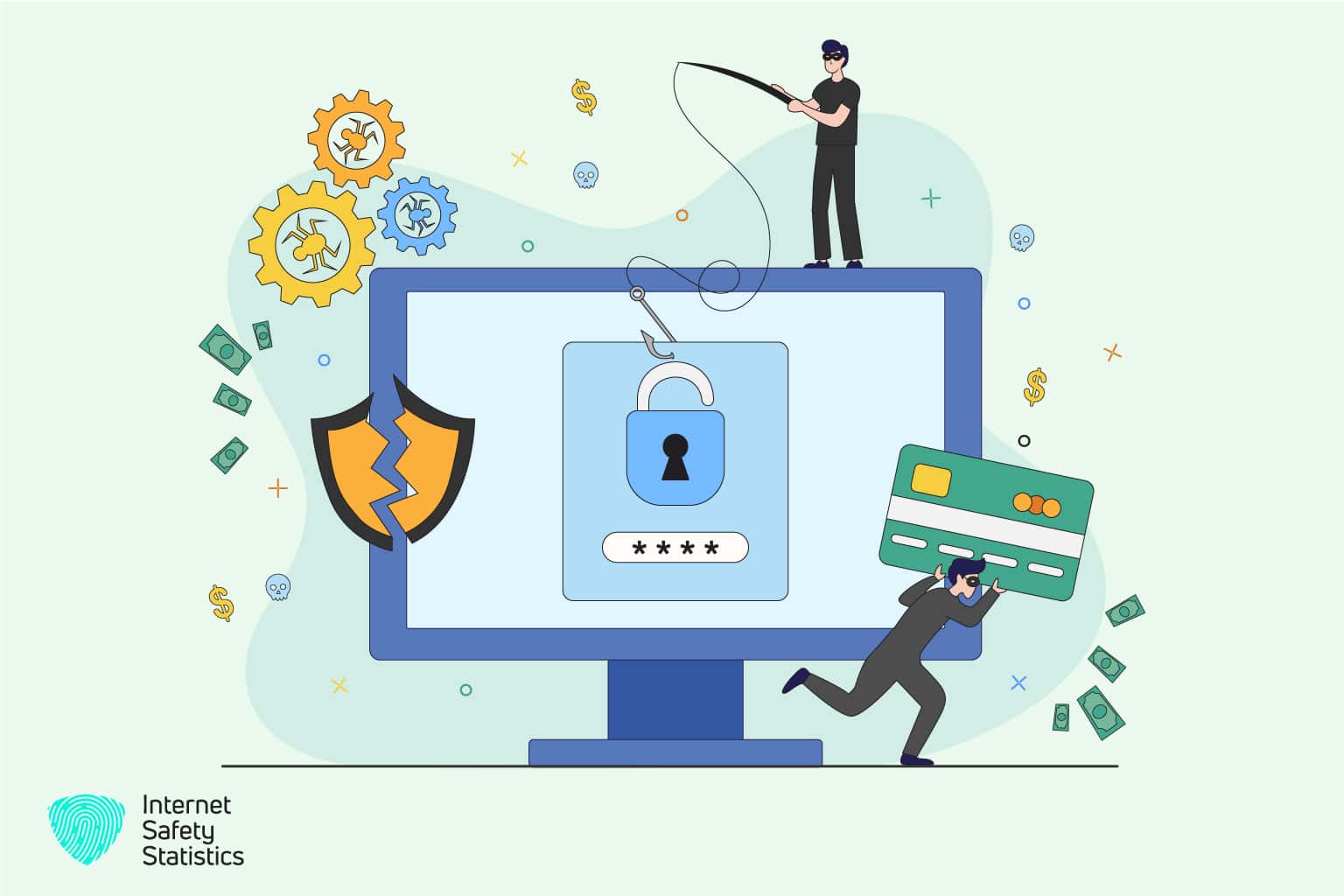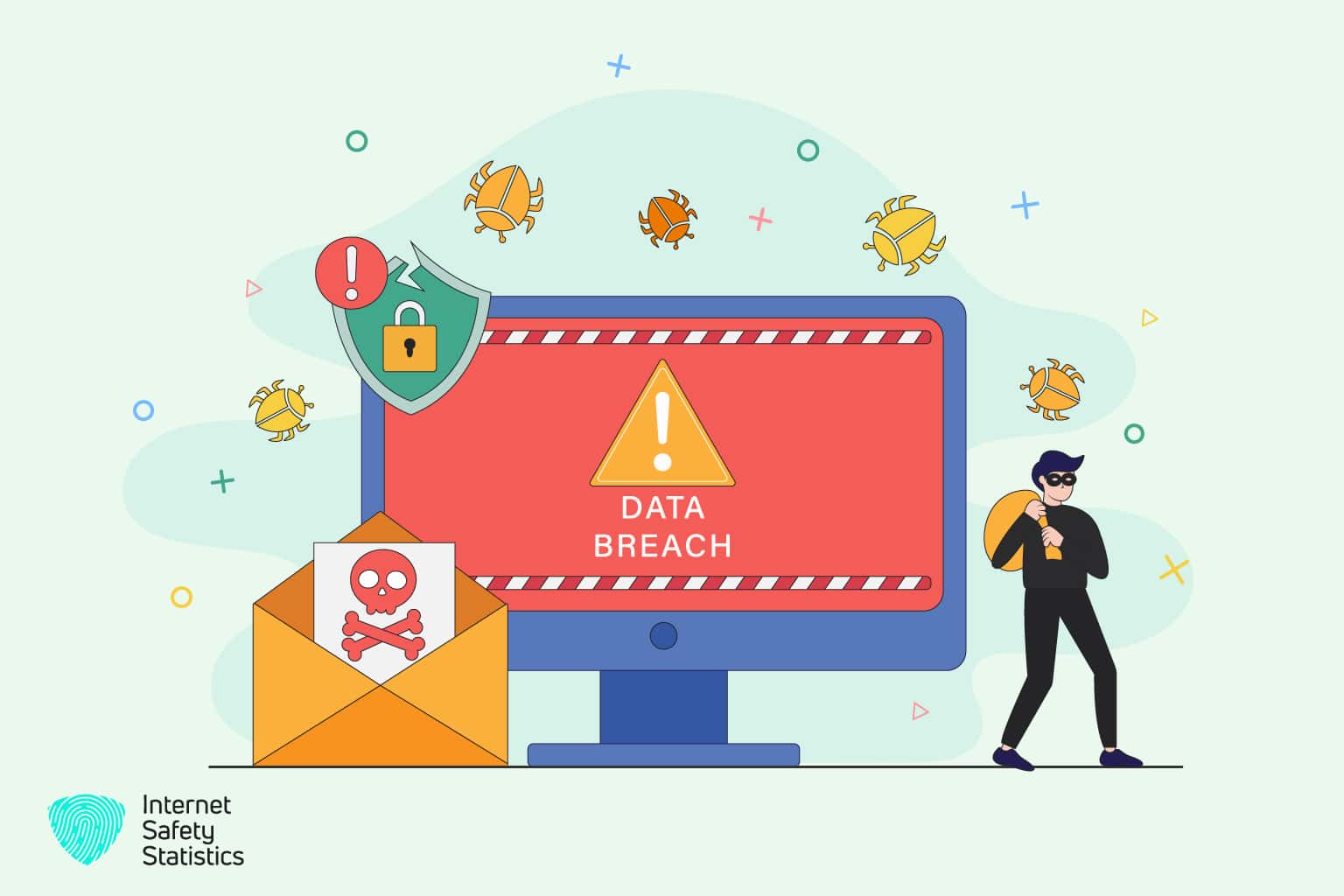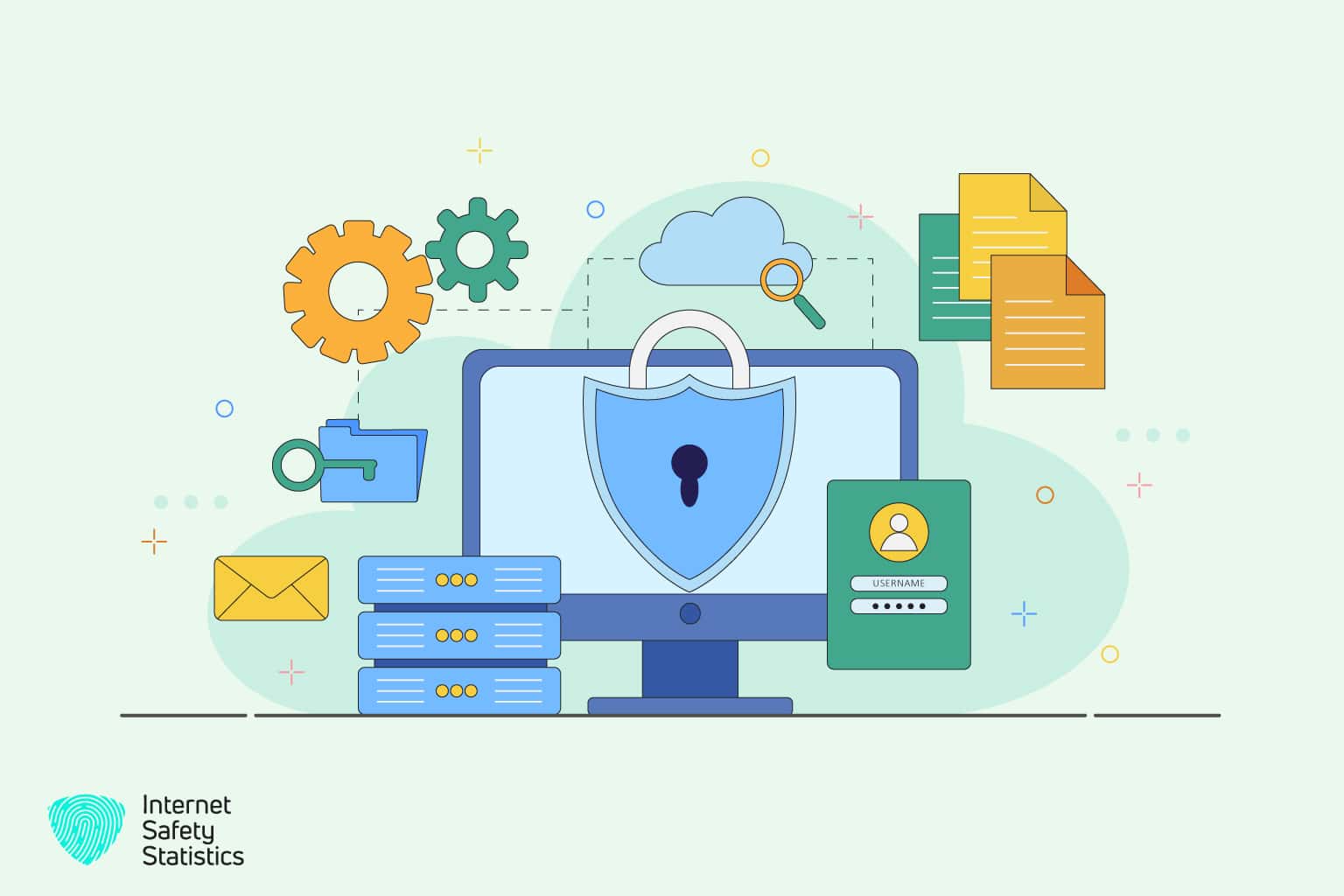
Data breaches have unfortunately been on the rise in the past few years, and the trend is only expected to continue. Until now, an estimated 22 billion records were exposed as a result of data breaches in 2022 alone. The statistics estimate that nowadays, a data breach takes place almost every minute. Hackers are strengthening their techniques by keeping up with the latest cybersecurity trends, and IT specialists, on the other hand, are still trying to keep up.
In this article, we will discuss what a data breach is, how and why it happens, the steps a hacker takes to steal data, what happens when there’s a data breach, and how to prevent it.
What is a Data Breach? And how does it happen?
A data breach happens when an unauthorised person gains either legal or illegal access to the victim’s data. The unauthorised person is a hacker who can get legal access to data by stealing the login credentials of the victim or one of the employees in the organisation and then using these credentials to access sensitive information. A hacker can gain illegal access by exploiting a loophole in the victim’s network, such as a misconfiguration or outdated software, and then installing malicious factors on the victim’s device to steal data.
There are other ways through which a hacker can gain access to secured data, such as:
• Guessing passwords.
• When the victim downloads software or other media from untrusted sources, which inadvertently installs malware on their device.
• Clicking on a phishing link from an email or text message or forwarding the link to other contacts.
• Physically losing devices with sensitive data.
• Losing paperwork with sensitive information.
• Leaving important paperwork unattended at the work desk or leaving sensitive data on display on the computer screen and then leaving the office.
• Sending sensitive information to the wrong email recipient.
Why do hackers hunt data?
Hackers can have multiple targets when they breach your database. These targets can range from individuals, in the case of a beginner hacker who is testing their skills out, to small businesses afterwards. In recent years, most data breaches were either politically motivated or aimed at making illegal monetary profits by targeting big and critical businesses. The latest statistics show that a single data breach can cause damages worth $4.35 million.
When a hacker breaches your database, he will either steal the information before wiping it from your hard drive and threaten to disclose the information to the public or sell it on the black market or encrypt all the data on your hard drive before demanding a ransom in exchange for the decryption key.
The Steps of a Data Breach
When we think of a data breach, we think the hacker just enters some code and then gains access to the victim’s device. In fact, there are several steps the hacker takes before reaching the data he decides is worth stealing.
1. Research
A hacker will conduct research about the organisation he intends to target to find all the information he needs to help him prepare for his attack. He can use the court and financial records to dig for information regarding the organisation’s cyber security expenditures, especially if they have hired a specialised company as their cyber security guard. Additionally, a hacker can find an access point to their target organisation through a partner company.
2. Scan for Vulnerabilities
The hacker will then scan for the organisation’s open ports and systems to find a possible entry point, such as a vulnerability in the system he can exploit.
3. Determine which Vulnerability to Exploit
By using exploit code, which is a code that works to take advantage of the detected security vulnerability, the hacker will run the code to determine the best method of entry.
4. The Breach
There are several ways the hacker can breach the database: he can install malware on the selected device, encrypt data in preparation to ask for ransom, or conduct DDoS attacks, just to list a few.
5. Data Theft
The hacker will eventually extract the data he intended to steal from the victim’s device and transfer it to his. He can then either wipe the data from the victim’s device or encrypt it to ask for ransom.
What happens when there’s a data breach?

A data breach can have many negative —sometimes destructive— effects, such as:
1. Identity Theft
The hacker can steal the victim’s personal information or social security numbers to take loans and steal the money, pay their own bills, or even file tax returns. They illegally use legitimate information to perform legitimate operations but for other people.
2. Monetary Loss
According to statistics, a single data breach cost $4.35 million on average in 2022. This reflects the massive monetary loss that data breaches can cost. Even though the last statistic mainly included big organisations, individuals and small organisations also incurred significant financial losses.
3. Less Productivity
Detecting and handling a data breach is not as simple as writing about it. Organisations can take up to 280 days (three-quarters of a year!) to spot a breach and later contain it. Additionally, spotting a data breach requires resources, which may consume the IT team’s time and affect their productivity in the rest of their tasks.
4. Bad Credit and Reputation
An organisation depends greatly on its credit and reputation to attract customers. When there’s a data breach, even if the data was recovered, it instils worry in the consumer’s mind and makes him think again before seeking the organisation’s services. On another note, if the hacker steals an individual’s identity and uses it to secure loans or steal money, such actions will label the individual with bad credit. When the individual eventually has their identity returned, they will still have bad credit from the hacker’s previous actions.
5. Customer Loss
A breach in an organisation’s database will cause the loss of vital information. Breached data can include information about the organisation’s financial records, transactions, and sensitive customer data, such as credit card numbers. In many cases, hackers exploit the data they stole before the organisation is able to detect there’d been a breach. Hence, customers start to incur losses from the theft of their information.
As a result, the organisation will lose a great number of customers, who will search for other competitive organisations that can offer them the same services, especially if data breaches continue to take place or the old organisation takes a long time to contain them.
6. Breached Privacy
A data breach can result in disclosing information people intend to keep private, such as personal information on dating websites. If the victim was an individual, the data breach could be in the form of data encryption and the threat to release or sell this private information on the black market if the victim didn’t pay the ransom.
7. Intellectual Property Loss
Intellectual property theft increased during the past years with the increasing dependency on technology to write or produce artistic works, store them, or send them off to publishing organisations. If the hacker steals the victim’s creative works, this can lead to huge losses and possible lawsuits by or against the victim. If there’s a label or publishing organisation in contract with the victim that finds the stolen works sold elsewhere, they can file a lawsuit against the victim. Similarly, if the victim themselves finds the work first, they can file a lawsuit against the owners of the website onto which the work was leaked.
8. Ransom
Recent statistics estimate the average cost of a ransomware attack, without the actual sum paid as ransom, to be $4.62 million per attack. Ransomware attacks represent the majority of malware attacks, with phishing emails being the most common method used to deliver ransomware. In the first half of 2022, statistics reveal that a staggering 236.1 million attacks occurred, with one taking place every 11 seconds.
9. Website Crash
If your organisation has a website, a hacker may cause the website to crash with a data breach. This can especially occur if he conducts a distributed denial of service or DDoS attack, which will disrupt services and bring the website down. Such vandalism will cost money and effort to get the website back and running.
What happens when you discover a data breach?
When discussing data breaches, it’s vital to know that no one is immune from them. Even tech-savvy individuals and organisations with top cyber security plans can fall victim to data breaches. What matters more is understanding what to do when you discover a data breach. This differs for individuals and organisations.
1. Individuals
If you discovered a data breach on your device, these quick steps can help you prevent further damage:
• Call the creditors: contact all financial institutions you deal with, such as the bank or the credit card company, to check your account for suspicious behaviour, which they will run by you to confirm whether or not you conducted such transactions. If suspicious behaviour presents itself, the institution can also close your old account and open a new one for you.
• Credit Report: when you freeze your credit report, you are preventing the hacker from creating new accounts using your stolen identity. You must know that this step will not negatively affect your credit score. If the breached data included your banking information, call the bank and have your account or card replaced and the old one cancelled.
• Fraud Alert: if the data breached included your social security number and you’d rather not freeze your credit report, you should request a fraud alert. This alert means that organisations are obliged to inform you before issuing credit in your name. Another step you can take is to file your tax report to prevent the hacker from using your social security number and information to file a tax report with your name on it but with someone else’s taxes.
• If your login credentials were stolen, you can log in from another device and change them, or you can contact the service itself and ask them to close the account for you. Additionally, if you had the same login credentials for more than one website, it’s best if you change them all into different strong passwords.
2. Organisations
Organisations store massive amounts of data, so when a data breach takes place, they face great consequences. Here are some steps your organisation can take after detecting a data breach:
• Find out who discovered the breach: in numerous cases, the person who discovered the data breach can be the person who unintentionally caused it. So, make sure to get their full view.
• Detect the vulnerabilities: a hacker’s first entry method is through exploiting vulnerabilities, so you should have your team double-check and fix any vulnerabilities.
• Secure organisation devices: while not likely, it’s better to secure your workplace from possible intrusions until the data breach is resolved.
• If you run a website, it’s better to have it checked to make sure it wasn’t affected or vandalised.
• Notify your suppliers and customers: as dreadful as this can be, it’s necessary for them to keep track of the accounts they linked to your organisation for suspicious behaviour.
How to Prevent a Data Breach?

As previously mentioned, data breaches can happen at any time and to professionals as well. However, there are steps you can follow, as an individual and an organisation, to make it difficult for hackers to breach your system.
1. Secure Your Network and Endpoint
Secure your network using firewalls and intrusion detection systems, among other tools, to stop any unsolicited connections from accessing your server. You need to also use malware-checking software, such as antivirus and antimalware, to secure the endpoint of your work and ensure that all the workload your employees finish is properly scanned for threats.
2. Limited Access
Grant access privileges to personnel who only need this specific information, which will help you keep track of such privileged access.
3. Data Assessment, Encryption and Backup
Data assessment entails deciding which data is important. Such data must be encrypted and stored. It’s crucial to know where to store it, whether using cloud services or physical storage devices. As a business, you should ask the customer to share strictly necessary information, which will make data encryption and storage easier.
Then you need to have all sensitive data encrypted, preferably not sharing the decryption key with other personnel, unless necessary. The last step is to back up all the sensitive data you encrypted, preferably to another server other than the main organisation server, to prevent the hacker from accessing it.
As an individual, you must have all your vital information backed up to an external drive and not restore the backup until you’ve cleared your device from malicious factors.
4. Training and Education
As an individual, it has become necessary to have better knowledge of the different aspects of cyber security, especially if you use additional AI and IoT devices. As a business owner, you need to provide your employees with proper cybersecurity training and education since they are the first line of defence against cyberattacks.
5. Regular Software Update
Regular software update allows your device to have the latest cyber security protection techniques available online. Hackers intently follow software updates in order to define new ways to beat them, so it’s vital for you to keep yourself protected.
6. Regular Infrastructure Patching
Unpatched software remains one of the most exploited entry points. Hence, your IT security team must keep your infrastructure updated regularly.
7. Regular Monitoring
Regular monitoring includes monitoring the network infrastructure to make sure to swiftly detect and contain any possible vulnerabilities or intrusions. In this regard, using AI tools is the best effective and time-saving method. These tools analyse patterns and user behaviour to search for anomalies and report back to the IT personnel in charge.
8. An Action Plan is a Must
As a business, you can devise an appropriate action plan with the management and IT teams. This plan should explain the steps to follow in the case of a cyber security attack, and you must then have this plan explained properly to your staff to ensure they fully understand it.
9. Passwords
As an individual, your passwords must be strong, of proper length and use different characters, and each of your online accounts must have its own distinct and strong password. As an organisation, you must implement strong password policies, make sure to password-protect devices with vital information and program them to shut down after a certain period of idleness.
In the cyber security world, you can’t guarantee ultimate protection, but you can always be vigilant with protective steps to keep unwanted visitors out.
